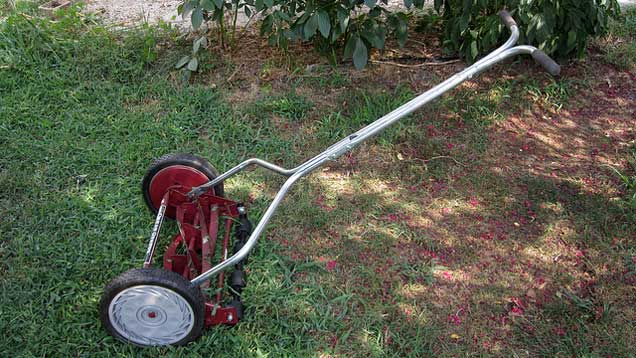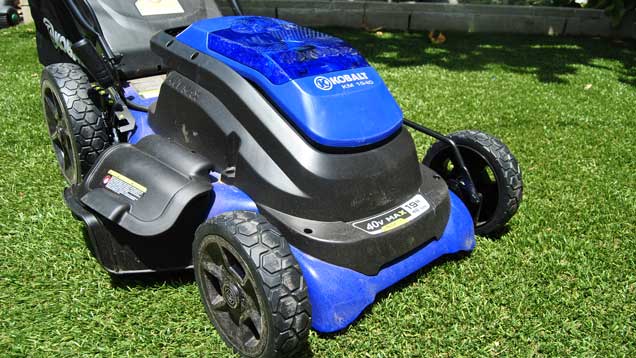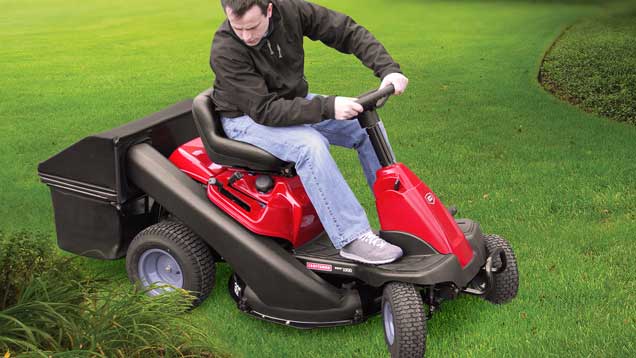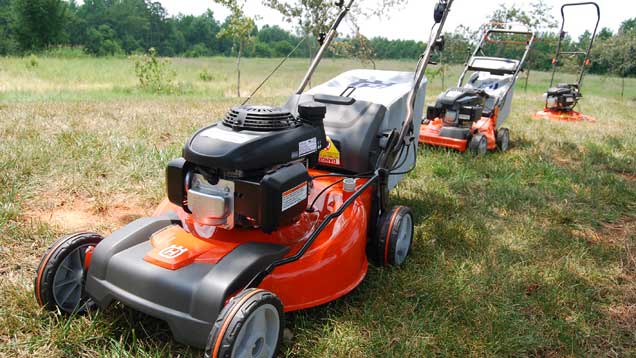Even as the weather cools, you still have to mow the lawn. If you’re confused about what type of mower you need or you’re just looking to justify the cost of upgrading, read on.
Photos by Charles & Hudson, Tony Alter, Craftsman
Personal preference and budget play a pivotal role for many people when it comes to mowing their lawn. Some people view it as a therapeutic workout and don’t mind pushing a mower for two hours, while others consider it a chore to be finished as quickly as possible. However, the type of lawn mower you need will largely be determined by three factors: the size of your lawn, level of terrain (flat or hilly), and the number and type of obstacles (trees, flower beds and so on).
Push Mowers Are Great For Little Lawns That Need Love

A small patch of grass (under 50 square metres) can be easily mowed using a manual reel mower. You’ve got to move a bit faster to activate the blades properly, but there is no engine (so it’s low maintenance and eco-friendly) and the mower can be stored vertically against the wall.
Walk-Behind Mowers Give You Options Galore

Powered walk-behind mowers have been an Australian staple for years. With the proper care, these two-stroke powered mowers can run for years and cut miles of lawn. Walk-behind mowers are available in a range of sizes. Remember to measure the width of your gate or shed door so you have enough space to manoeuvre your mower through.
Beyond width, there are a couple other major features to consider when selecting a walk-behind mower:
Petrol or electric: Petrol mowers have longer runtime and offer more power than electric, but they can be messy and require more maintenance than their electric counterparts. Electric mowers can be corded or cordless and are much cleaner to operate than gas, but unless you have two batteries (for cordless), there is always a chance you could run out of juice. Of course, with a corded model you’re limited by the length of your cord, which can be a nuisance to mow around.
Push or self-propelled: If self-propelled, is it two or all wheel drive? All-wheel drive will provide more assistance going up inclines but they are heavier and can be more difficult to manoeuvre.
Cutting type: Walk-behind mowers deal with grass clippings in one of three ways: side discharge, which distributes the clippings back onto the lawn; mulching, which cuts the clippings into very fine pieces which break down and release nutrients back into the soil; and bagging, which collects clippings into a bag which is disposed of with your green waste.
Go For A Ride If You Have A Huge Lawn

Riding mowers are made for lawns that are just beyond the scope of anyone wanting to push a walk-behind mower. If it takes you more than two hours to mow your lawn it might be time to upgrade. Riding mowers have a rear-mounted motor and only provide the basics in comfort. They’re built for mowing smaller lawns and finishing the job quickly.
Lawn tractors are a big step up and offer more powerful engines and wider cutting decks. Some offer power takeoff (PTO) capabilities which allow you to hook up attachments such as spreaders, aerators, or snow throwers to your lawn tractor. Advanced features to look for include four-wheel steering, headlights, high-back seats, 12 volt outlets, and cruise control.
Zero-turn mowers have been popular with landscapers and golf course maintenance for years. They offer faster speeds and precision turning, but the lap bar steering can be difficult for some to learn. They are ideally suited for large flat lawns with large obstacles such as trees or ponds to mow around.
Before buying a mower, try out as many as you can in the type you need. This will go a long way in preventing buyers’ remorse. For ride on mowers, you’d never buy a car without a test drive, so don’t do the same with a mower.

Comments
5 responses to “How To Choose The Right Lawn Mower”
find the cheapest push mower you can with a briggs and stratton 4stroke motor and buy that. Mixing 2 stroke is a pain in the arse, and of course go with self-propelled if you have some physical limitation.
Or advertise you’re disposing of broken mowers, and drain the carby of water and sharpen the blades and done.
People are idiots with mowers and most mowers thatre sent for repairs or thrown away it’s usually blunt blades or water in the carby.
Also don’t touch bar blades you’re asking for trouble. I personally use a toro self propelled with a 32 inch cut for small stuff and a diesel kubota zero turn for big stuff. Course I mow lawns for a living. 120 an hour up here in the tropics. Apparently it’s hot but when you grow up outside its easy to handle. Cold on the other hand bugger that keep your below 20 down south.
A more important thing if buying new is brush cutters/wipersnippers is don’t cheap out. Get a Honda 4 stroke power head and don’t get fishing line lead, get something nice and thick and wavy, and don’t waste your time with tap heads.
Summary of best features by mower type:
Reliability (best to worst): 1. electric 2. two stroke 3. four stroke
Noise (quietest to loudest): 1. electric 2. four stroke 3. two stroke
Weight (lightest to heaviest) 1. electric 2. two stroke 3. four stroke
Maintenance (least to most) 1. electric 2. four stroke 3. two stroke
Power* (most power to least power) 1+2. two and four stroke 3. electric
* I am yet to see a grass that can’t be cut with an electric mower. Buffalo grass is one of the toughest varieties, and it is cut like butter.
Two strokes are more reliable than four strokes (less moving parts), fiddly (adding petrol and oil, filters), they are the noisiest. When you hear a lawn mower down the street, it’s a two stroke.
Four strokes are less reliable than two strokes (more moving parts), less fiddly than two strokes (no oil), moderately noisy. When you hear a mower from 2 doors away, it’s a four stroke.
Electric mowers are the most reliable, lightest, least fiddly (no oil, petrol or filters). If your grass is far stronger than any variety of grass known to humans, then you will need the extra power of two stroke or four stroke over electric – otherwise, any mower is strong enough to cut grass. Time wise, I notice no difference. Effort wise, electric is about as easy as it gets (unless you have self-propelled).
If you want the easiest to use and lift, lightest, lowest maintenance mower you can buy, electric is ideal. Electric mowers come in two varieties, with batteries and with power cord. The battery tends to have a short life (1-3 years is a reasonable life for a battery). If you use a cord, the mower weighs about as much as a vacuum cleaner – and makes far less noise than a vacuum cleaner. The cord can be a pain, unless you mow in rows, from one side of the lawn to the other.
If you really do want a petrol mower, one of the best brands is Honda. For about $1500 you can get a great model (eg. the Honda HRU216 and its variants) are great. You may need to make some mods for air filters and the likes, but it’s often used by commercial lawn mowers.
Dan your summary of features doesn’t make any sense..
You don’t very clearly define the difference between 2 and 4 stroke.
2 stroke less reliable easier repairs, less maintenance, quicker power, less torque. 4 stroke more reliable, more expensive repairs and heaps of torque but can take awhile to get there.
At least he took the time to provide a summary and some useful information. Added far more value than your shitty comment.
Sure does.. But at least I didn’t provide information that was wrong.
Question 1. Is it a Honda?
If you answered YES to question 1 you have the right mower.
Can anyone give advice on engine size and blade dimensions for a medium sized, flat yard with not too many obstacles?
Can anyone give advice on engine size and blade dimensions for a medium sized, flat yard with not too many obstacles?